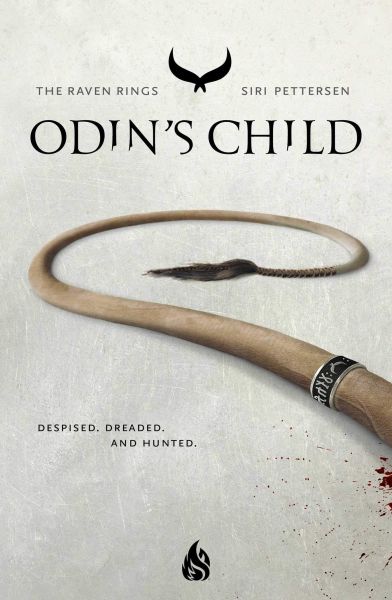Ask The Old Grey Standing Stones
Odin’s Child (Raven Rings, volume 1)
By Siri Pettersen (Translated by Siân Mackie & Paul Russell Garrett)

2 Jun, 2021
0 comments
2013’s Odin’s Child is the first volume in Siri Pettersen’s Raven Rings trilogy. It was first published in Norway in 2013. The 2021 English translation is by Siân Mackie and Paul Russell Garrett.
Why cannot Hirka channel Might, the earth-magic that pervades her world? Why doesn’t she have a tail, as all proper Ymlings do? Why should she lack the Ymling tail and talents? She doesn’t know.
Until her fifteenth year, she and her father Thorrald could conceal or explain away her deficiencies from the world. Now she faces the Ymling rite of passage, a rite that will reveal her lack of Might. It’s not clear how the authorities will react.
Thorrald knows what she does not. Hirka is Thorrald’s adopted daughter, and she was born tailless because she is no Ymling. She comes from another world. She is an Odin’s Child. As far as most Ymlings are concerned, that would be enough to prove she is cursed. Hirka, once she learns from her father the truth, fears they might be correct. Which does not mean she doesn’t still want to live.
The Blind once came from another realm. They were mystical leeches who drained their victims of magic and life. No Blind have been seen since the age of heroes, a thousand years ago, but they are still remembered. Everyone knows that the Blind do not have tails.
The Blind entered the world of Ym (the fact that Ymlings have tails and magic should be enough of a hint) via the standing stone circles scattered across Ym. It was by one such circle that Thorrald found infant Hirka fifteen years ago. Until now, the Blind were the only entities known to have visited Ym via the stones. Came via stones? Tailless? It’s easy to jump to the conclusion that Hirka is one of the Blind. Any reasonable Ymling would have killed the tailless infant on the spot or at least left her to freeze. Thorrald was too tender hearted. Now the time has come to pay the price for his act of mercy.
Or perhaps not. One of the eleven kingdoms, Ravnhov, is verging on
open rebellion. The northern holding has ignored Council rulings but has so far avoided repercussions. Thorrald and Hirka could do worse than to flee to Ravenhov. Alas, Thorrald was crippled in an accident and cannot easily flee.
There’s another danger. One Councillor is also unhappy with the status quo. Urd feels he doesn’t get enough respect and has turned to dark magic. This hasn’t worked so far — has in fact had terrible consequences for him — but as Ymlings (and humans) do, he redoubles his efforts. His first foray into forbidden rites was fifteen years ago. Hirka appeared by a standing stone circle fifteen years ago. Could his actions have brought Hirka from another world?
It could be that she’s a threat to Urd’s schemes … or that she might be necessary to them. Once Urd learns that Hirka exists at all, the megalomaniac will take a very close, very unpleasant interest in the girl.
Danger on all sides.
~oOo~
The author expects readers to fill in certain blanks. We have to figure out that this book isn’t set on our Earth; the tails are a hint. Yes, the Ymlings mention Odin, but if entities can go from world to world, so can religions and gods. For that matter, just as Ymling tongue has been translated into English, so perhaps Odin is the closest analog to the god after whom the Odin’s Children are named.
The author eventually clues us into another fact about this setting: there are more than two worlds. Yggdrasil has many branches.
Thorrald has been very careful to maintain a low profile, moving from town to town whenever the neighbours took too close an interest in him and his daughter. It’s rather unexpected, therefore, that Hirka is on speaking terms with a surprising number of people who are intimately connected to the Council. One of her childhood friends is Urd’s bastard (he raped a woman). Her childhood frenemy and future love-interest Rime An-Elderin is by blood entitled to a seat on the Council and is in addition a Kolkagga (a Norse ninja, more or less). There may be highborn in Mannfalla who are not as well connected as one red-haired foundling from the sticks. There may be Councillors who envy her connections.
Not super plausible, although the author does provide an explanation. Rime wants to avoid his powerful relatives and hit on the same nowhere town to lay low. His pushy kin visit to berate him. It’s handy to the plot.
Odin’s Child has many of the sort of things I like, despite which I enjoyed it less than I had hoped. The translation may be the issue; the characters felt a bit flat. As well, the plot felt somewhat padded. There are more captures and escapes than seemed likely (or necessary to the plot). A leaner approach might have worked better. Nevertheless, I intend to see where the author takes the trilogy.
Odin’s Child is available here (Amazon US), here (Amazon Canada), here (Amazon UK), here (Barnes & Noble), here (Book Depository), and here (Chapters-Indigo).
